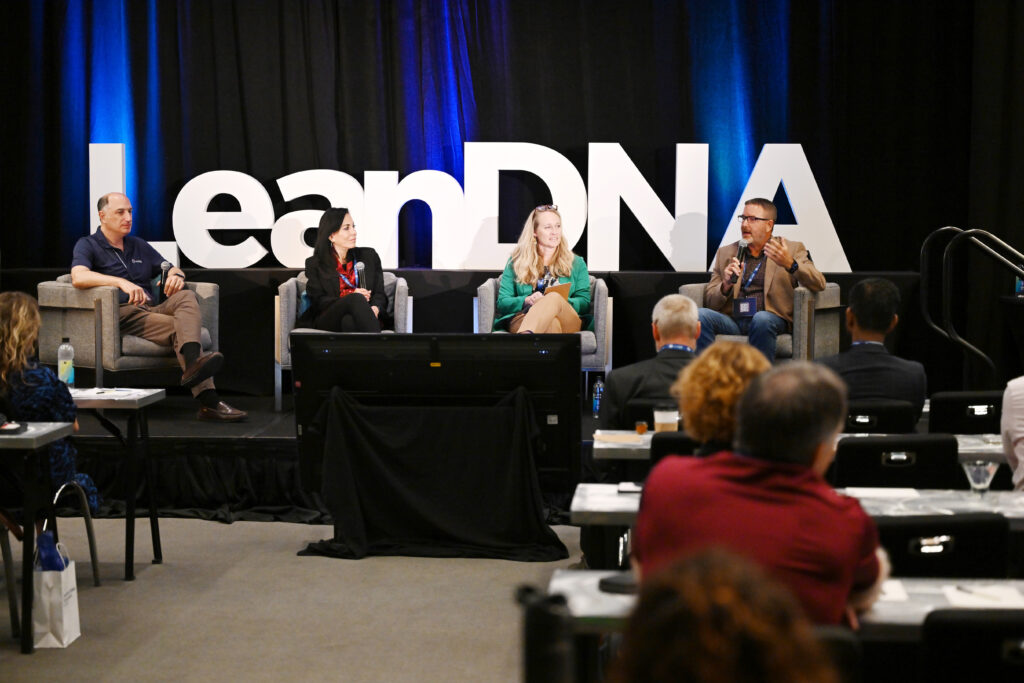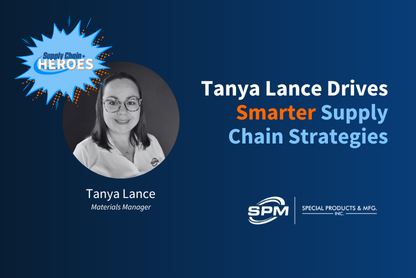The global manufacturing landscape is at an inflection point. Decades of operational optimization, followed by years of sustained volatility, have forced manufacturers to re-evaluate where they create value.
The 2025 Manufacturing Excellence Summit brought together 85+ supply chain leaders from over 40 different companies and brands across various industries for two days of strategy and collaboration in Austin. This gathering provided a unique look into the core priorities and challenges of top manufacturers.

During those two days, what stood out most was the shift in mindset going into 2026: supply chain isn’t simply being managed, it’s being reimagined as the driving force behind innovation, resilience, and long-term value creation. Leaders agreed that now is the time to move beyond the era of tactical firefighting and pull up a chair to the strategic side of the business. The future demands a fundamental shift toward data-driven foresight, strategic alignment, and proactive collaboration.
The conversations and shared experiences at the summit revealed key trends for the year ahead. Here are the top five themes that are dominating strategic discussions across the industry as we head into 2026:
Theme 1: The Strategic Elevation of Supply Chain
The biggest shift is not what supply chain does, but how it communicates its impact. With chronic disruptions, the C-suite has started to pull the function out of the basement and give it a seat at the table. However, summit speakers emphasized that this opportunity comes with a caveat: reframe the narrative.
“It may be one thing for us to think in terms of suppliers and scorecards, but we need to be communicating in terms of risk to the business, risk mitigation, actions we are taking sourcing strategies and how we're mitigating and changing our sourcing strategy to adopt that” stated Mike Kienitz, CSCO at Signia Aerospace.
Supply chain leaders need to stop speaking in the language of operational metrics and start communicating in the language of the business: Revenue, EBITDA, working capital efficiency, and risk mitigation. Supply chain is now viewed as an investment in resilience and growth, and its leaders must champion that perspective.
"Traditional metrics, like on-time delivery... are important, but you translate those. On-time delivery leads to customer loyalty, market share growth, and brand improvement... Aligning with strategic pillars in your organization and showing where you are articulating value to those strategy pillars is key.” said Swetha Reddy, VP, SIOP and Materials at Duravant.
Theme 2: Digital Transformation and Data-Driven Execution
The most significant barrier to strategic action is fragmented data. The summit recognized that manufacturing issues are often “painfully local” and require a move beyond siloed spreadsheets and isolated decision-making. Technology solutions, like APEX, were framed as the "glue" necessary to connect disparate systems and provide a standardized, single source of truth.
“Pulling data took a lot of time and energy. With LeanDNA everyone has full access and is not reliant on one person or a huge manual effort to get the data they need to make decisions and take action.” -Chris Lynn, VP of Procurement at TurboChef.
The objective is to achieve execution excellence. This means leveraging platforms to highlight infrastructure gaps and give teams clean, actionable intelligence, allowing them to shift from reacting to bad data to executing on precise insights. This transition also frees up specialized talent, allowing planners and buyers to move away from tedious data aggregation and toward strategic root-cause analysis and problem-solving.
Theme 3: Proactive Management and Foresight
Manufacturing organizations must move out of perpetual reactive mode. While visibility was the goal of the past decade, foresight is the mandate for the next. This involves leveraging new capabilities like Agentic AI and tools like APEX Inventory Optimization to anticipate supply disruptions, optimize inventory, and stabilize execution before problems escalate.
The key to escaping the daily firefighting cycle is empowering teams with the right data to address root causes, not just symptoms.
“We use LeanDNA to initiate and understand the root cause of shortages. This enables and empowers our teams to focus on what truly matters, which we then tie to key performance indicators and goals. The result is faster decisions, stronger collaboration, and ultimately, better outcomes,” stated Eric Blanton, Global Purchasing Manager at MSA, The Safety Company.
The ultimate aim is a closed loop between planning (S&OP) and execution (Operations). Insights gleaned from the frontline, the daily execution data, must continuously feed back into the planning process to improve long-term optimization and ensure the business is truly proactive. This connection moves a manufacturer from simply reacting to past events to anticipating and shaping future outcomes.
Theme 4: The Criticality of People, Process, and Tools Alignment
A recurring message at the summit was that technology, while essential, cannot solve fundamental organizational issues. True operational excellence requires the deliberate alignment of people, process, and tools. Technology acts only as an amplifier; it cannot fix a broken process or a disengaged team.
This reality was underscored by James Dawsey, Director, Supply Chain Data and Technology at Modine Manufacturing, who emphasized the hard limit of technology alone: “Tools are only going to get you as far as the process and the people behind them.” He also spoke to the inherent passion of the workforce and the evolving talent requirements, noting, “People don’t join supply chain on a whim; they join supply chain because they have a passion.” Leaders must focus on fostering this talent and providing the clear processes necessary for success.
For this alignment to take root, organizations must prioritize communication and change management. Suzanne Maddux, VP of Supply Chain at Mercury, emphasized that this shift is not just about adopting a new system, but changing how teams interact and think: “Alignment starts with creating space for people to have a conversation and ask questions.” She added that the digital solutions themselves can be a powerful catalyst for this cultural shift: “The tool is allowing us to stretch the way that people engage.” This highlights that the process of implementing a new tool is as much a cultural and communication project as it is a technical one.
Theme 5: Collaboration: Internal and External
The final, overarching theme of the summit addressed the human element of transformation. Even with the best data and most capable tools, progress stalls if people and teams resist new ways of working. Success requires navigating change management to unlock true collaboration, both inside organizations and across the supplier base.
The toughest hurdle is often the internal mindset, where the temptation is to hold onto familiar, but inefficient, processes. Craig Schmitz, Senior Procurement Manager at Johnson Controls, articulated this challenge clearly: “Our biggest challenge is the mindset change. This is how we do it, we’re special, we’re different. That has been our biggest struggle.” The solution, he noted, is not force, but value demonstration: “You have to be able to go to them and show the value as a whole. Share successes across your multiple teams. Show them that you can make small incremental changes to make their lives better.”
This internal alignment is the prerequisite for moving forward, as Elena Rodriguez, Global SIP & Materials Management Director at Flowserve, stated: “Collaboration is what moves the company initiatives.”
Externally, collaboration must be scaled to the supplier base. The summit highlighted the crucial shift required from transactional supplier tracking (the endless email chase) to strategic partnership. Successful, large-scale supplier collaboration involves connecting hundreds of global suppliers across numerous sites.
To achieve this scale, Nicole Rowe, Director of LeanDNA at Johnson Controls, shared critical lessons learned:
- Top-down leadership support is non-negotiable for driving the change initiative.
- Internal teams (Procurement, Materials, and Manufacturing) must be clearly aligned on goals and processes.
- Start small, then scale, implementing lessons learned along the way, to avoid biting off more than you can chew.
- Establish common KPIs, governance, and processes to monitor and drive desired outcomes.
The benefit of mastering these challenges is profound: it transforms supplier collaboration from a manual, resource drain into a reliable driver of efficiency and execution. When change management enables clear processes and powerful tools, the resulting digital connectivity allows organizations to mitigate risk, gain accurate commit data, and unlock significant time savings for both their teams and their supply partners.
Conclusion: Empowering the Next Era of Manufacturing
The 2025 Manufacturing Excellence Summit confirmed that the future of supply chain is strategic, data-driven, and focused on people. Moving forward means translating these themes into a reliable, systemic competitive advantage. The era of manual, reactive crisis management is giving way to one of predictive foresight, where people, process, and technology are aligned. Now is the time to empower better inventory decisions at every level by providing your teams with technology that amplifies their judgment, turning complex data into clear, prioritized action that happens where it matters most.
To explore how these new solutions can help you make the shift from reactive to proactive, learn more about APEX Inventory Optimization and the Kei AI Assistant. You can also sign up for an upcoming webinar to see these new capabilities in action.






